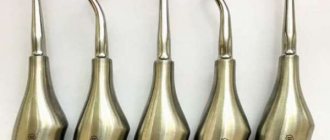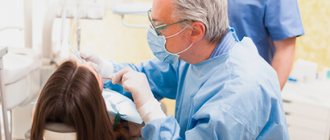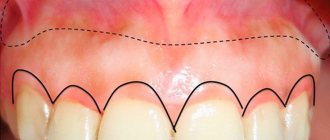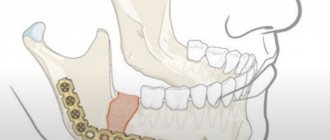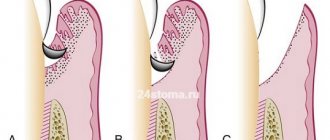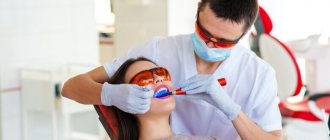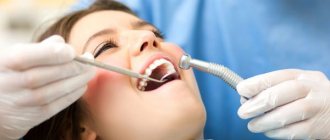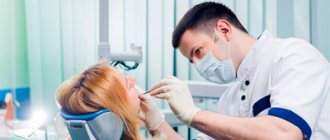A laser is a device that produces laser radiation. Laser dentistry uses lasers in procedures. Unlike ordinary light, laser radiation has much greater power because all its beams move together and their wavelengths are the same. Thanks to this quality, laser beams are easily focused and turned into a narrow beam.
What devices are used in dentistry
Various types of lasers are used in dentistry:
- Carbon dioxide (CO2).
Used in dental surgery to perform various manipulations on soft tissues.
- Diode. It is used in dental cosmetology for working on soft tissues, for teeth whitening, as well as for sterilizing root canals and sealing dentinal tubules in case of increased tooth sensitivity.
- Erbium. Designed for the treatment of hard dental tissues.
Using a fast and precise laser beam, the dentist can do without a drill or scalpel. The laser does not contact the tissues directly, but evaporates water from them. In this case, bacteria die and tooth enamel becomes denser. The laser beam works very delicately; it does not affect healthy tissue, does not burn, does not vibrate or make noise. After the procedure, patients do not experience any discomfort.
Problems eliminated by laser beam
These properties allow the laser to be used to take the following therapeutic measures:
- removal of dental stones;
- treatment for periodontal diseases (gingivitis and periodontitis);
- getting rid of the consequences of caries and granuloma.
The disinfecting and biostimulating effect of using laser dental equipment makes it possible to fight the following infectious diseases:
- herpes rashes on the lips;
- aphthous stomatitis;
- ulcers;
- painful cracking in the corners of the mouth.
Practice has confirmed the high efficiency of laser equipment when performing the following therapeutic procedures:
- decreased sensitivity of enamel and its whitening;
- sealing fissures in children's teeth and correcting wedge-shaped defects;
- installation of implants;
- correction of various defects of the oral cavity.
It should be noted that getting rid of such a dangerous disease as granuloma using a laser beam is not accompanied by tooth extraction, but can be done conservatively, using transcanal dialysis:
- after analyzing the x-ray and external examination, a diagnosis is made;
- the canal (or filling, if it was previously installed) is opened, expanded and processed with aseptic material;
- a waveguide connected to the laser emitter is inserted into the prepared channel;
- the granuloma is exposed to the targeted beam for the required time;
- the liquid inside the granuloma evaporates, the capsule narrows, the tooth root is sterilized;
- the channels are disinfected and sealed;
- adhesive and filling material is applied.
Further, if there is a need for this, work is done to model the crown and install it.
The use of anesthetics and antibiotics is kept to a minimum, which is very important when treating children and adults prone to allergic reactions.
Laser treatment of patients is possible at the initial stage of periodontitis and is carried out in the following sequence:
- After diagnosis, the doctor removes plaque and hard deposits, including under the gum;
- Photoditazine is applied to the treated areas, which is washed off after 10 minutes;
- The laser emitter is directed to the subgingival area.
The treatment course involves two sessions with a six-month break.
Indications and contraindications for the use of lasers
With the help of a laser, it is possible to help even those patients whose treatment with traditional methods of dentistry did not produce noticeable results. First of all, the laser is indicated for children, as well as patients with periodontal diseases, aphthous ulcers, gingival hyperplasia, allergies to standard anesthetics and dental hypersensitivity. However, this method also has contraindications: cancer, acute purulent inflammation in the oral cavity, severe heart disease and the post-infarction period, complex forms of vascular diseases, tuberculosis, severe diabetes mellitus and blood diseases.
Fast healing
When using laser surgery, minimal tissue necrosis is observed, in most cases there is no postoperative swelling, and the wound is completely sterile. For these reasons, healing occurs faster and the use of additional antibacterial drugs is not required.
Comment by periodontist surgeon A.Yu. Nogina: “I personally like the laser as a bloodless cutting method for operations to correct the frenulum and vestibule of the oral cavity. Accordingly, the less bleeding, the less swelling, the less pain, and the faster the healing. This increases patient comfort. Plus the sterility of the wound.”
Laser dental treatment
A laser beam removes carious tooth damage with high precision. This technique prevents overheating of the pulp during preparation, prevents the appearance of microcracks in the enamel, and destroys bacteria in the treated area. Using laser radiation, an ideal surface for filling is created, and post-filling pain is eliminated.
Laser can also solve the problem of dental hypersensitivity. During treatment, the hard tissues of the tooth are “sealed” and the nerve endings are sealed.
Principle of operation
By heating the surface of the tooth, most of the liquid is removed from it. After this, the “protected” inflamed space is released. The laser beam burns out all harmful microorganisms and frees up space for further mechanical cleaning.
Treatment of dental cysts with a laser is carried out similarly to any other operations. A cyst is a formation with dense, hard walls, inside of which there is a large amount of bacteria or dead tissue. Outwardly it may not be noticeable, but in everyday life it causes great discomfort. In particular, previously a dental cyst was treated with great effort.
This purulent sac forms in the roots, so to remove it, in any case, it would be necessary to remove the tooth, clean out the abscess and install an implant in its place. There is another method - surgical. To carry it out, an incision is made in the desired place of the gum, corresponding to the cyst, the dentist-surgeon uses instruments to pull out the bag, and then sutures the tissue.
Laser treatment of periodontitis
Treatment of periodontitis often requires the use of surgical methods (especially in the late stages of the disease). Laser treatment gives quick and good results. Using a laser beam, periodontal pockets are completely sterilized. After the destruction of the pathogenic microflora, which is one of the causes of inflammation, patients immediately notice improvements: the gums almost stop bleeding, less pus and ichor are released from the periodontal pockets, and pain during meals decreases.
Traditional treatment of caries
In the traditional treatment of caries, cavities in the teeth are cleared and leveled with a drill. It is clear that in this case, tooth tissue is inevitably destroyed. Chips and microcracks appear - the gateway to future infection. Laser treatment disinfects carious canals. Inflammation of the pulp, the soft tissue inside the tooth, is also relieved. The canal cavity itself becomes dense from the instant evaporation of moisture from it, its loose carious walls are destroyed, sharp irregularities are smoothed out. The laser beam penetrates the bone much deeper than conventional disinfectants and destroys bacterial colonies. Using laser beam pulses, the doctor creates a lumpy surface on which the filling will adhere perfectly. But the main thing is that the chances of complications are sharply reduced.
Laser treatment of canals
Endodontic canal treatment requires the highest standards of disinfection. The laser beam destroys the bacterial membrane, evaporates soft tissue and bacterial colonies. And due to the high temperature, the hard tissues of the walls of the root canal are partially melted and its thin branches are “sealed”. This prevents communication with periodontal tissues and allows maintaining sterility in the root canal cavity. This type of root canal treatment is a quick and painless procedure that greatly increases the effectiveness of endodontic treatment.
Dental implantation
- — cutting the gums to install implants,
- — opening of implants after their engraftment,
- — antiseptic treatment of the implant bed,
- – treatment of peri-implantitis – inflammation around installed artificial roots
Dental restoration through implantation is one of the main indications for the use of a laser device. “Laser scalpel” allows you to create not only aesthetics of the gums, but also significantly reduce the rehabilitation period due to less tissue trauma: swelling and pain are reduced, bleeding from the wound stops, tissues heal 2 times faster.
Laser surgery
Plastic surgery of the frenulum of the lips and tongue is performed using a laser. The operation takes place without pain and blood, and due to minimal tissue damage, the healing process is faster.
In addition, the laser is successfully used in the treatment of gingival hyperplasia, a disease that is expressed in the pathological covering of the tooth with gum tissue. Laser surgery can effectively remove excess tissue and completely restore the normal appearance of the mucous membrane.
Another area of laser application is cosmetic reconstruction of the gum level. In some patients, when they smile, too much gum is exposed, or its level in different places is asymmetrical. Using a laser, the gum level can be raised. Without a scalpel and anesthesia, the gums acquire clear edges, and the smile becomes attractive.
All the best for children
Laser therapy is successfully used in the fight against caries even in baby teeth, although only at the initial stage of the lesion. It is advisable for the child to be at least seven years old, but diligent and calm children can take advantage of the latest technology at a younger age.
For the treatment of small patients, the following rules apply:
- it is necessary to use only equipment with the ability to adjust the radiation power;
- During the procedures, a slight tingling sensation may occur, which the child should be warned about.
All other advantages of laser dentistry are common to children and adult patients.
Laser in physiotherapy
Physiotherapy is a section of restorative medicine aimed at treating and regenerating damaged tissues. Laser physiotherapy is used if the patient has an advanced inflammatory process. For the recovery procedure, an infrared laser is used, the duration of which is only one to two minutes. This physiotherapy does not cause side effects, and thanks to the laser, the postoperative period is shortened and becomes as painless as possible.
And yet, despite the universal properties of the laser beam, such treatment cannot be called a panacea. Working with a laser system requires a very highly qualified doctor, and due to certain difficulties in treatment and limitations, lasers must be used with caution and strictly according to indications.
Advantages
- Gentle influence. A laser beam entering an air-water jet gently removes damaged areas. At the same time, it seals the vessels. This reduces the risk of bleeding;
- High accuracy. The laser beam affects only damaged tissue. It does not affect healthy areas;
- Safety. High hygiene is maintained during any manipulation. Pathogenic bacteria do not enter the cavities. All grooves and grooves are securely sealed;
- No pain. There is no room for discomfort in laser dentistry. Patients can do without anesthesia, which is especially important for pregnant women, children, and people suffering from allergies;
- No seams. Even when performing complex surgical laser operations in dentistry, there is no need for sutures. The laser is capable of sealing the edges of wounds;
- No discomfort. The laser does not heat up and does not make noise;
- Versatility. The laser can be used to treat the teeth of young patients, pregnant women and even during breastfeeding.
Mechanism of therapeutic effect
The OPTODAN laser in dentistry creates infrared radiation that can penetrate soft and hard tissues, and is completely painless. Organic molecules absorb emitted photons, then oscillatory processes occur that trigger:
- accelerated regeneration of soft and bone tissues;
- pronounced anti-inflammatory and analgesic effect;
- destruction of thrombotic masses and restoration of blood flow;
- increased oxygen supply to tissues and normalization of metabolic processes;
- strengthening immune defense.
The operation of the OPTODAN device is suitable for all ages. In our clinic, children are very frequent guests for laser treatment, because this technique is completely painless and does not cause discomfort.
Laser dentistry
The laser, it would seem, is capable of working miracles. Laser dentistry is becoming available and is offered at our Imagelab clinic. Laser technologies are actively used in ophthalmology, cosmetology, surgery, and for active physiotherapy of soft tissues. In reality, lasers are capable of incredible things—things that were previously unattainable.
Patients already know well the features of the equipment and types of lasers used in aesthetic procedures and hair removal. In dentistry, it is also time to focus on high technology. And it’s not even about the requests of patients, but about the opportunities that laser technologies provide to the doctor.
Laser dentistry, technologies and equipment
The Nizhny Novgorod dental clinic “Image Lab” has installed Waterlase MD equipment (Biolase, USA). This is a unique installation that was developed by Nasa for the aerospace industry. The new solution used in Waterlase MD has no analogues at the moment. This technology combines the use of a water jet and a laser.
Now you can treat your teeth with surgical precision, without pain or discomfort and with the highest quality. If we talk about technological features, scientists have achieved the optimal degree of laser absorption by water. According to the technology, laser energy with a specially selected wavelength (2780 nm) enters every microdrop of water, which leads to a microexplosion, which is used as a source of hydrokinetic energy.
Benefits of laser dentistry
With the help of the presented equipment, our dentists can do incredible things with complete comfort for patients; laser dentistry in Nizhny Novgorod is:
- completely painless procedure;
- no unpleasant sounds from the drill; no extraneous sensations or sounds during laser treatment;
- bloodless laser cuts with instant tissue coagulation, in most cases there will be no bleeding;
- instant restoration of damaged tissue due to the low traumatic procedure, no scars;
- completely sterile conditions that meet all clinical standards.
Obviously, this method of treatment is especially popular with young children who do not like going to the dentist.
Laser dentistry – hard tissue processing technologies
Laser dentistry technologies make the dental treatment process not only painless, but also of exceptional quality. The quality level of any operation is an order of magnitude higher than the quality of even the best drill. Laser dental treatment will never compare to conventional dentistry. Here is a list of what can be done with a dental laser:
- preparation of carious inclusions for filling, the possibility of treating cervical caries, as well as eliminating a wedge-shaped defect;
- no microcracks are formed during tooth processing;
- The laser makes it possible to remove dental tissue affected by caries with high precision. Dentin and enamel are not damaged.
As a result:
- a perfectly clean tooth surface, ready for filling;
- The laser is used for endodontics, at the same time pulpotomy and pulp extirpation are carried out, as well as cleaning from decay products. The tooth canal is simply cleaned, expanded and sterilized;
- with the help of a laser they cut, contour, resect, and grind teeth without typical traditional injuries to bone and soft tissues;
- eliminate hypersensitivity of teeth and necks.
Treatment of tooth roots with laser
Laser technologies are applicable for endodontic treatment: - for pulp therapy; — to gain access to the root canal; — for root canal treatment; - for root sterilization; - for apiectomy (nerve removal).
Laser treatment of gums and soft tissues
Using the device, the following high-precision and low-traumatic operations on soft tissues are performed:
- removal of herpetic manifestations and aphthous stomatitis; removal of neoplasms such as papillomas, fibromas, hypertrophied areas, without stitches;
- periodontal operations and reduction of the depth of periodontal pockets;
- correction of gum shape for aesthetic procedures;
- removal of tongue frenulum;
- cutting through the gums during the growth of wisdom teeth;
- sutures after laser surgery on soft tissues already have an aesthetic appearance, operations take place without discomfort and tissue swelling.
We would like to add on our own behalf that patients who have tried laser treatment once in their lives never return to regular dentists. Laser dentistry is a fundamentally new word in modern medicine!
